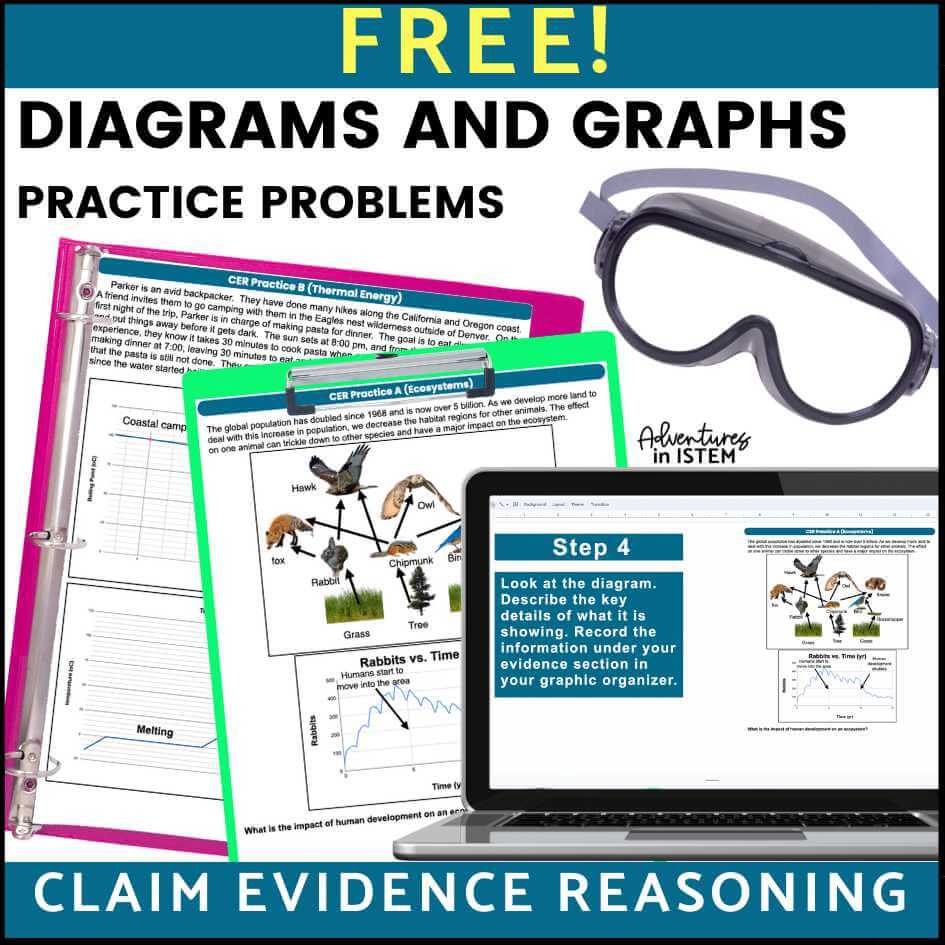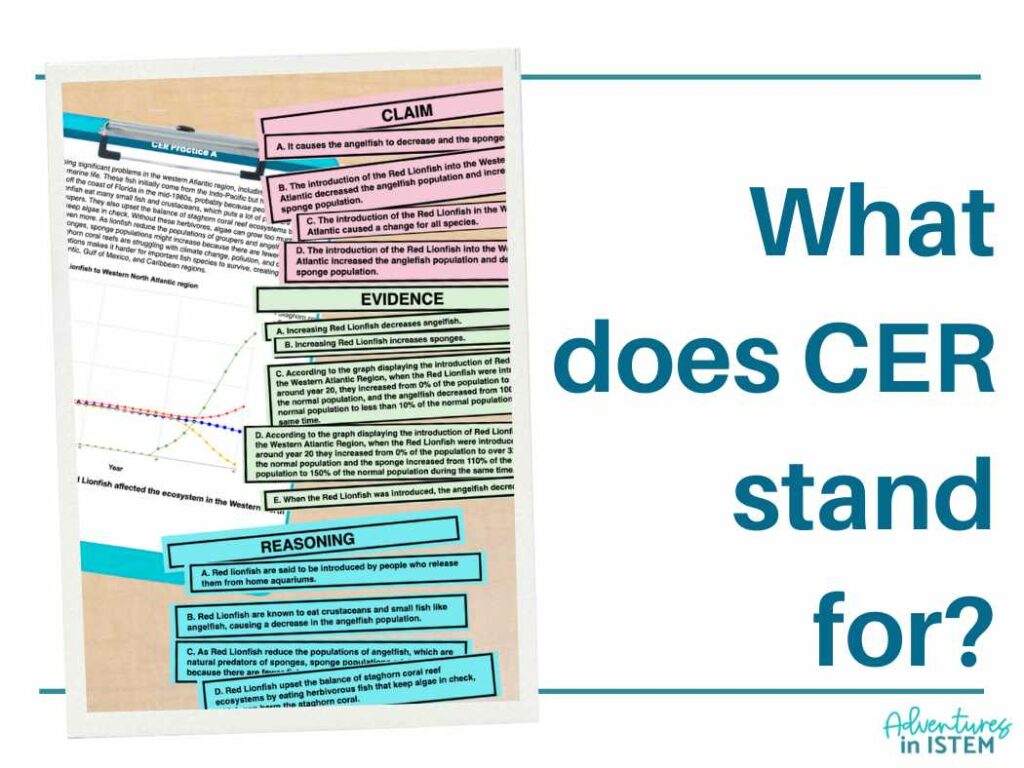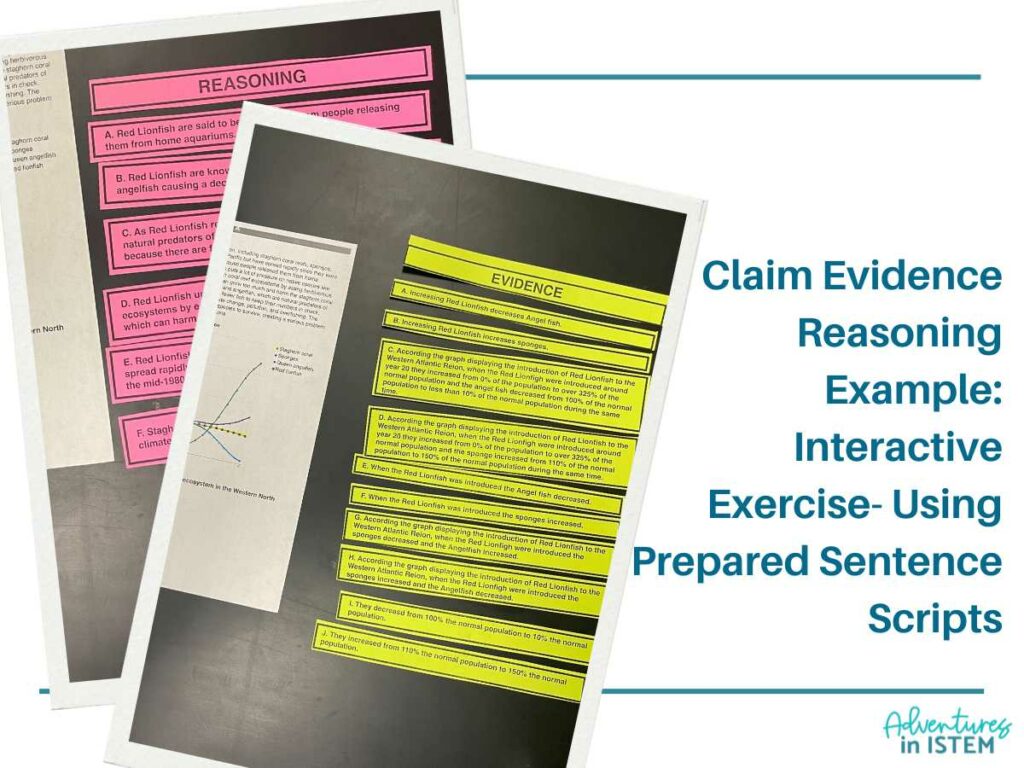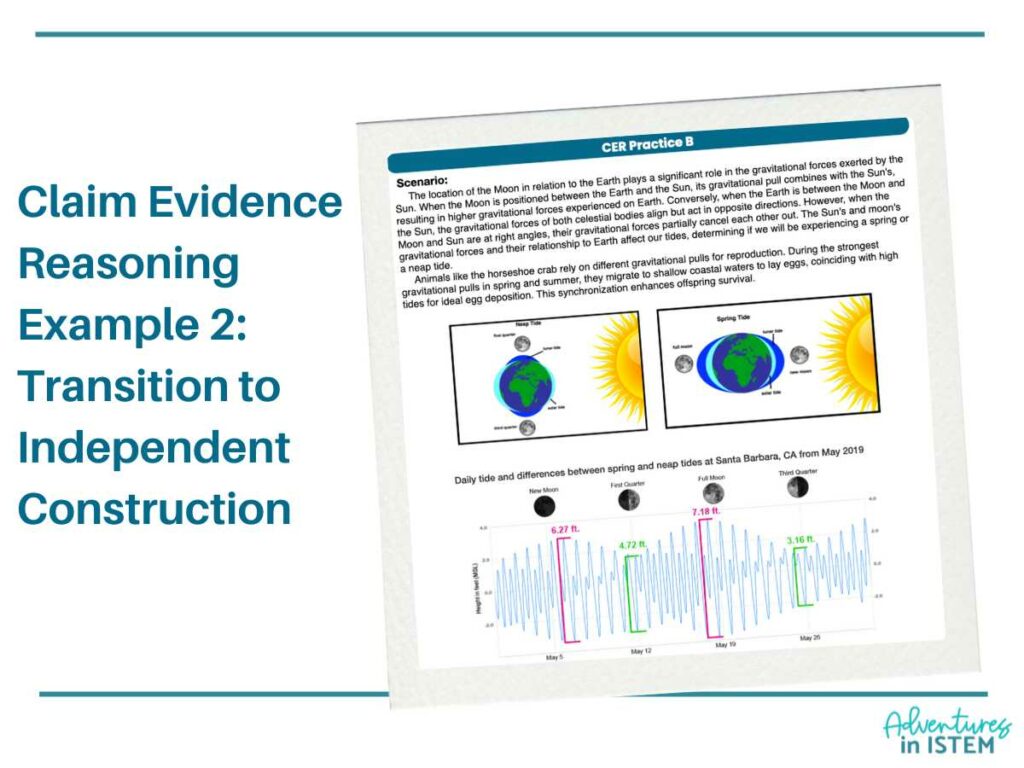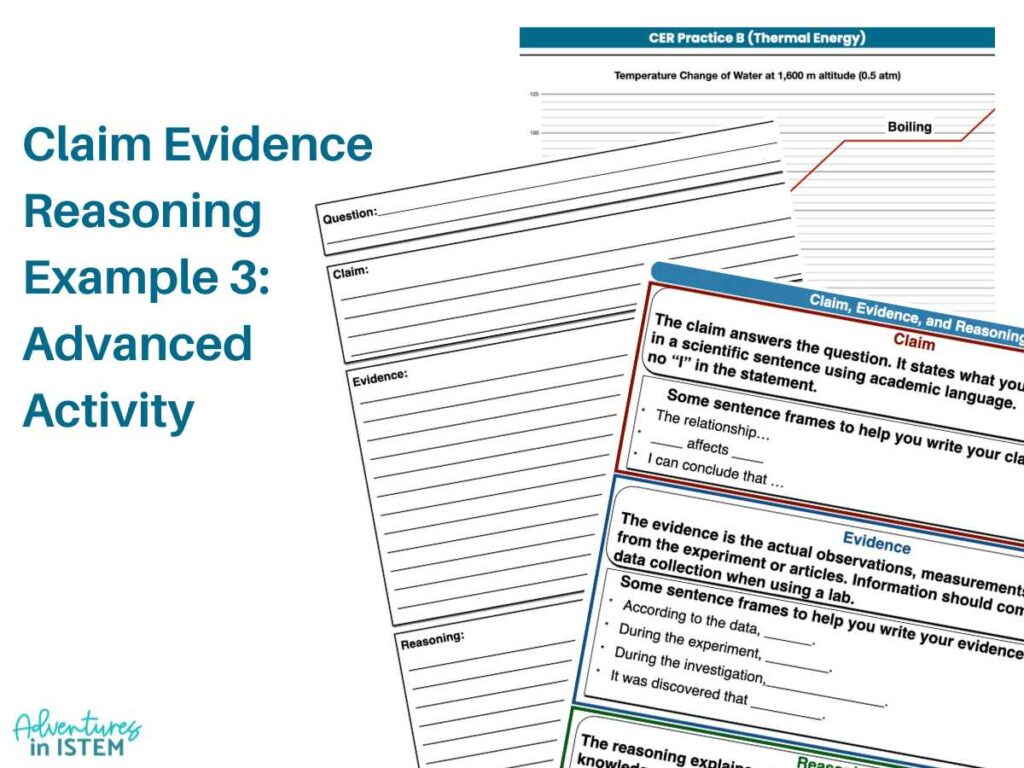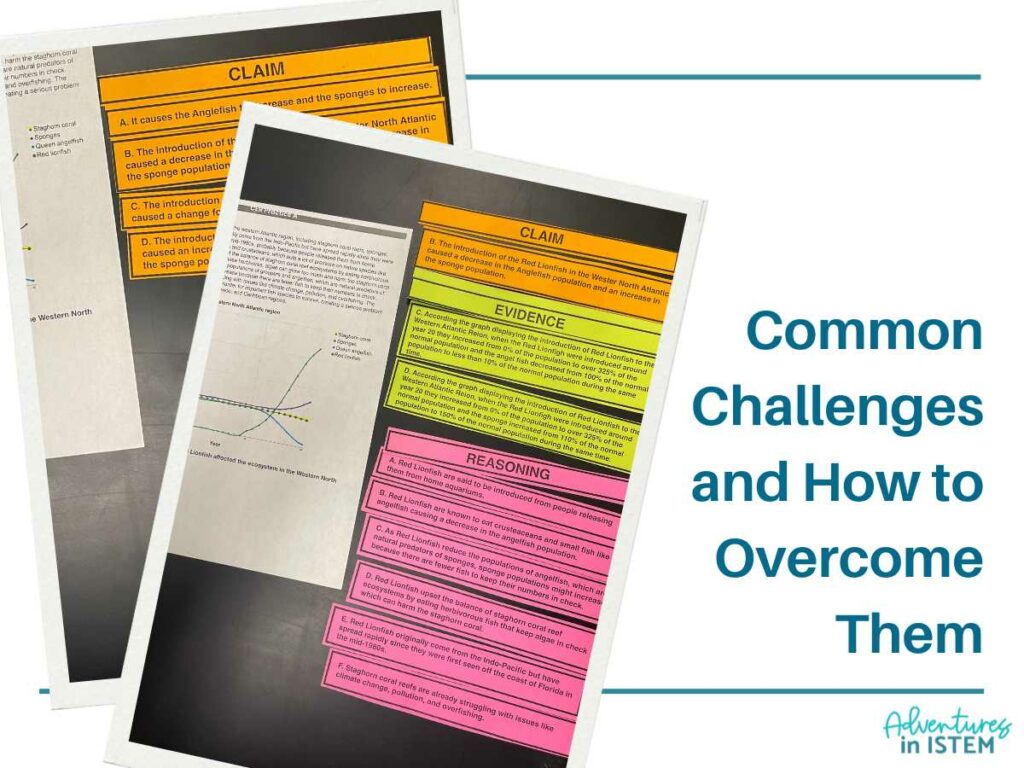I have found that my students struggle to write clear claims, evidence to support their claims that includes data from graphs or tables, and reasoning sentences that explain how the evidence supports the claim. This is why I have decided to scaffold how I teach my students how to properly write a claim evidence reasoning paragraph. I want to take you through the process with these claim evidence reasoning examples.

Understanding the Components of CER
Explaining the ‘Claim’
A scientific claim is a statement or conclusion that answers a question or problem. I try to explain to students that their claim sentences should include keywords from the question. I have found that my students benefit from using “Claim Evidence Reasoning Sentence Starters” to build a solid foundation for their arguments. These starters help formulate precise and well-grounded claims, setting the stage for a compelling scientific argument.
Gathering ‘Evidence’
The strength of any scientific claim lies in the evidence provided. Students must select credible and directly relevant evidence to their claims. Effective use of evidence supports the claim convincingly, demonstrating a clear understanding of the topic and the inquiry process. I try to stress to my students that their evidence must come from diagrams, graphs, and tables. They should give the numbers of what the graph and tables are showing when appropriate.
Formulating ‘Reasoning’
Reasoning is the glue that connects the claim and the evidence. It involves explaining why the evidence supports the claim and is critical in making the argument coherent and compelling. Tips for clear articulation include using logical connectives and ensuring that the reasoning explicitly links the evidence to the main claim. This is where the students explain what the graph, diagram, and tables are showing and why and how the information from the evidence supports the claim.
Claim Evidence Reasoning Example 1: Interactive Exercise- Using Prepared Sentence Scripts
I found that using an interactive exercise with prepared sentence scripts was highly beneficial in helping my students practice and understand how to write Claim, Evidence, and Reasoning (CER) paragraphs. Here’s a detailed setup for this activity.
Activity Setup: Begin by providing students complete sentence scripts, each carefully crafted to illustrate potential claims, evidence, and reasoning. For each component of the CER—claim, evidence, and logic—present students with at least 4-5 sentences from which to choose. It’s crucial that within these choices, only one or two sentences will correctly support the construction of a robust scientific argument, while the others will contain common errors or misconceptions.
Selection Process: Students are tasked with selecting the most appropriate sentences that form a logical and scientifically valid argument. This selection process is critical as it challenges students to critically evaluate each sentence’s relevance and accuracy in relation to the claim they are supporting.
Discussion of Choices: After making selections, facilitate a discussion regarding why specific sentences were effective and others were not. This part of the exercise is essential for reinforcing the learning objectives. Discuss the common pitfalls of the less effective sentences, such as irrelevant evidence, unsupported claims, or reasoning that fails to connect the claim and evidence logically.
Learning from Errors: By analyzing the sentences that do not work, students learn to identify and avoid similar mistakes in their writing. This method helps them understand what makes a sentence effective and the common errors that can weaken a scientific argument.
Reinforcement Through Practice: Encourage students to practice this exercise multiple times with different sets of sentences. Repetition will help them become more familiar with the components of a strong CER paragraph and improve their ability to construct clear and persuasive scientific arguments.
This structured exercise helps students learn to assemble a clear CER paragraph by choosing the correct claim, supporting it with appropriate evidence, and linking it with sound reasoning. It also deepens their understanding of how scientific arguments are constructed and evaluated.
Claim Evidence Reasoning Example 2: Transition to Independent Construction
As students develop proficiency in identifying the critical components of effective Claim, Evidence, and Reasoning (CER) arguments through structured exercises, the next step is to foster their ability to construct arguments independently. This step is important to help them move from already created sentences to their sentences. Here’s how you can guide this transition effectively.
Introducing Sentence Starters and Word Banks: Introduce students to sentence starters for claims, evidence, and reasoning. These starters are designed to provide a scaffold that maintains the structure of CER while allowing flexibility for personal input. For example, claim starters might include phrases like “Based on the data, it can be concluded that…”, while evidence starters could be “The data shows that…”, and reasoning might start with “This evidence supports the claim because…”.
Usage of Word Banks: Alongside sentence starters, provide a word bank that includes key vocabulary and phrases relevant to the topics being studied. This resource helps students articulate their thoughts more precisely and encourages them to use scientific language accurately. Word banks should be comprehensive, including terms that link evidence to claims, describe data, and express logical connections, such as “therefore,” “consequently,” and “due to.”
Guided Practice: Initially, guide students through using these tools. For instance, present a partially completed argument where students fill in the blanks using sentence starters and words from the word bank. This practice helps them understand how to integrate these tools into their writing effectively.
Encouraging Independent Sentence Formulation: As students become more comfortable with the sentence starters and word banks, encourage them to begin formulating entire sentences independently. This step is crucial as it shifts them from filling in templates to thinking critically about how they construct each component of their argument. Encourage creativity and personal expression within the bounds of scientific accuracy and relevance.
Feedback and Iteration: Provide continuous feedback on their independently constructed arguments. Highlight strengths in their reasoning or evidence selection and discuss areas for improvement. This iterative process is essential for helping students refine their skills and gain confidence in writing compelling scientific arguments independently.
Progressive Removal of Scaffolds: Gradually reduce the reliance on sentence starters and word banks as students’ skills improve. This phased approach helps ensure that they do not become overly dependent on these aids and can apply the principles of CER in various contexts, including more complex or novel situations.
By carefully managing this transition, students learn to construct their own arguments and gain the skills necessary to engage deeply with scientific content, think critically, and express their understanding in a clear, structured, and scientifically valid manner. This approach fosters a deeper understanding of science and its methods, preparing students for more advanced studies and discussions.
Claim Evidence Reasoning Example 3: Advanced Activity
As students become more adept at constructing Claim, Evidence, and Reasoning (CER) arguments with the support of sentence starters and word banks, the final stage of development involves gradually phasing out sentence starters to promote greater independence in their scientific writing and thinking. This advanced activity focuses on just using a word bank as the primary tool, encouraging students to craft their own sentences more freely. Here’s how to facilitate this progression effectively.
Introduction of a Comprehensive Word Bank: Introduce a detailed word bank with a broad range of scientific vocabulary, phrases that signify causal and logical connections, and terminology specific to the studied content. This word bank is a supportive tool for students to accurately express scientific concepts and relationships without the framework of sentence starters.
Guided Practice- Without Sentence Starters: Begin this phase by encouraging students to construct complete CER arguments using only the word bank. Provide them with a specific scientific question or problem and ask them to formulate their claim, gather evidence, and explain their reasoning using appropriate terms from the word bank. Initially, guide them through this process by discussing how different words and phrases from the bank can be used to build coherent and logical arguments.
Encouraging Full Sentence Construction: As students grow more comfortable using the word bank, encourage them to craft complete sentences independently. This step is crucial for developing their ability to think critically and articulate their thoughts coherently. Encourage creativity and personal expression, ensuring they maintain scientific accuracy and relevance in their arguments.
Peer Collaboration and Feedback: Incorporate peer review sessions where students present their CER arguments to classmates and provide feedback to each other. This collaborative process reinforces their learning and helps them understand different ways of using the word bank to construct compelling arguments.
Challenging Scenarios: Introduce more complex or ambiguous scenarios that require deeper analysis and a more sophisticated use of language. These challenges help students refine their ability to use the word bank creatively and effectively, ensuring they can apply their skills in varied and complex scientific contexts.
Reflection and Refinement: Regularly have students reflect on their progress in independently using the word bank to construct scientific arguments. Discuss what strategies worked well, what areas need improvement, and how they can refine their use of the word bank to enhance clarity and persuasiveness in their writing.
Gradual Increase in Complexity: Continue to expand the word bank and increase the complexity of the tasks as students’ skills develop. This ongoing progression keeps them engaged and continuously improves their ability to formulate robust scientific arguments independently.
This advanced activity promotes greater independence in students’ scientific writing and thinking by focusing on the use of a comprehensive word bank and phasing out sentence starters. It encourages them to internalize the structure and logic of CER, enabling them to tackle scientific questions confidently and communicate their insights effectively.
Common Challenges and How to Overcome Them
Students often face challenges such as unclear logical flow or using irrelevant evidence. Strategies such as outlining their arguments before writing and peer reviewing each other’s work can effectively overcome these. These methods improve clarity and ensure the logical progression of their arguments.
Continuous practice is key to mastering CER. Suggest engaging exercises and activities that reinforce these skills, such as peer reviews and iterative writing sessions. These practices not only enhance students’ ability to use CER effectively but also foster a collaborative learning environment.
Mastering Claim, Evidence, and Reasoning is essential for scientific literacy. It equips students with the skills necessary to articulate clear and persuasive arguments. Students need constant practice with writing claim, evidence, reasoning sentences. Helping them go from already created sentences to sentence frames and finally to a word bank helps them develop their skill.
